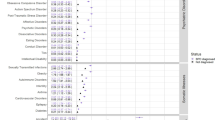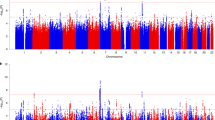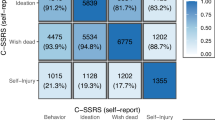Abstract
Most psychiatric disorders, when examined individually, are associated with a broad range of adverse outcomes. However, psychiatric disorders often co-occur and their co-occurrence is well explained by a limited number of transdiagnostic factors. Yet it remains unclear whether the risk of these adverse outcomes is due to specific psychiatric disorders, specific dimensions of psychopathology (i.e., internalizing and externalizing dimensions), a general psychopathology factor, or a combination of these explanations. In a large nationally representative prospective survey, the National Epidemiologic Survey on Alcohol and Related Conditions (NESARC), we used structural equation modeling to examine the shared and specific effects of common Axis I and Axis II disorders on the risk of ten adverse outcomes (unemployment; financial crisis; low income; poorer general health; worse mental and physical health; legal problems; divorce; problems with a neighbor, friend, or relative; and violence) in the general adult population. Effects of psychiatric disorders were exerted mostly through a general psychopathology factor representing the shared effect across all disorders, independent of sociodemographic characteristics and the presence of the adverse outcomes at baseline. Violence and legal problems were further associated with the externalizing factor, but there were no independent associations of the internalizing factor or any individual psychiatric disorders with any of the adverse outcomes. Our findings reveal that associations between psychiatric disorders and adverse outcomes occur through broad psychological dimensions. Understanding the biological and psychological mechanisms underlying these dimensions should yield key intervention targets to decrease the individual suffering and societal burden associated with common psychiatric disorders.
This is a preview of subscription content, access via your institution
Access options
Subscribe to this journal
Receive 12 print issues and online access
$259.00 per year
only $21.58 per issue
Buy this article
- Purchase on Springer Link
- Instant access to full article PDF
Prices may be subject to local taxes which are calculated during checkout


Similar content being viewed by others
References
Olfson M, Blanco C, Wall M, Liu SM, Saha TD, Pickering RP, et al. National trends in suicide attempts among adults in the United States. JAMA Psychiatry. 2017;74:1095–103.
Curtin SC, Warner M, Hedegaard H. Increase in suicide in the United States, 1999–2014. NCHS Data Brief. 2016;241:1–8.
O'Donnell JK, Gladden RM, Seth P. Trends in deaths involving heroin and synthetic opioids excluding methadone, and law enforcement drug product reports, by census region—United States, 2006–15. Morb Mortal Wkly Rep. 2017;66:897–903.
Oquendo MA, Volkow ND. Suicide: a silent contributor to opioid-overdose deaths. N Engl J Med. 2018;378:1567–9.
Case A, Deaton A. Rising morbidity and mortality in midlife among white non-Hispanic Americans in the 21st century. Proc Natl Acad Sci USA. 2015;112:15078–83.
Case A, Deaton A. Mortality and morbidity in the 21(st) century. Brook Pap Econ Act. 2017;2017:397–476.
Olfson M, Wall M, Liu SM, Schoenbaum M, Blanco C. Declining health-related quality of life in the U.S. Am J Prev Med. 2018;54:325–33.
Hoertel N, Franco S, Wall MM, Oquendo MA, Kerridge BT, Limosin F, et al. Mental disorders and risk of suicide attempt: a national prospective study. Mol Psychiatry. 2015;20:718–26.
Kessler RC, Akiskal HS, Ames M, Birnbaum H, Greenberg P, Hirschfeld RM, et al. Prevalence and effects of mood disorders on work performance in a nationally representative sample of U.S. workers. Am J Psychiatry. 2006;163:1561–8.
Rubio JM, Olfson M, Perez-Fuentes G, Garcia-Toro M, Wang S, Blanco C. Effect of first episode axis I disorders on quality of life. J Nerv Ment Dis. 2014;202:271–4.
Blanco C, Krueger RF, Hasin DS, Liu SM, Wang S, Kerridge BT, et al. Mapping common psychiatric disorders: structure and predictive validity in the national epidemiologic survey on alcohol and related conditions. JAMA Psychiatry. 2013;70:199–208.
Krueger RF. The structure of common mental disorders. Arch Gen Psychiatry. 1999;56:921–6.
Grant BF, Goldstein RB, Chou SP, Huang B, Stinson FS, Dawson DA, et al. Sociodemographic and psychopathologic predictors of first incidence of DSM-IV substance use, mood and anxiety disorders: results from the Wave 2 National Epidemiologic Survey on Alcohol and Related Conditions. Mol Psychiatry. 2009;14:1051–66.
Canino G, Bravo M, Ramirez R, Febo VE, Rubio-Stipec M, Fernandez RL, et al. The spanish alcohol use disorder and associated disabilities interview schedule (AUDADIS): reliability and concordance with clinical diagnoses in a Hispanic population. J Stud Alcohol. 1999;60:790–9.
Chatterji S, Saunders JB, Vrasti R, Grant BF, Hasin D, Mager D. Reliability of the alcohol and drug modules of the alcohol use disorder and associated disabilities interview schedule-alcohol/drug-revised (AUDADIS-ADR): an international comparison. Drug Alcohol Depend. 1997;47:171–85.
Grant BF, Dawson DA, Stinson FS, Chou PS, Kay W, Pickering R. The alcohol use disorder and associated disabilities interview schedule-IV (AUDADIS-IV): reliability of alcohol consumption, tobacco use, family history of depression and psychiatric diagnostic modules in a general population sample. Drug Alcohol Depend. 2003;71:7–16.
Hasin D, Carpenter KM, McCloud S, Smith M, Grant BF. The alcohol use disorder and associated disabilities interview schedule (AUDADIS): reliability of alcohol and drug modules in a clinical sample. Drug Alcohol Depend. 1997;44:133–41.
Grant BF, Harford TC, Dawson DA, Chou PS, Pickering RP. The alcohol use disorder and associated disabilities interview schedule (AUDADIS): reliability of alcohol and drug modules in a general population sample. Drug Alcohol Depend. 1995;39:37–44.
Ware JE.QualityMetric Inc, New England Medical Center H, Health Assessment Lab How to score version 2 of the SF-12 health survey (with a supplement documenting version 1). Lincoln, R.I.; Boston, MA: QualityMetric Inc.; Health Assessment Lab; 2005.
Rubio JM, Olfson M, Villegas L, Perez-Fuentes G, Wang S, Blanco C. Quality of life following remission of mental disorders: findings from the National Epidemiologic Survey on Alcohol and Related Conditions. J Clin Psychiatry. 2013;74:e445–450.
Elbogen EB, Johnson SC. The intricate link between violence and mental disorder: results from the National Epidemiologic Survey on Alcohol and Related Conditions. Arch Gen Psychiatry. 2009;66:152–61.
Reise SP, Morizot J, Hays RD. The role of the bifactor model in resolving dimensionality issues in health outcomes measures. Qual Life Res. 2007;16:19–31.
Tackett JL, Lahey BB, van Hulle C, Waldman I, Krueger RF, Rathouz PJ. Common genetic influences on negative emotionality and a general psychopathology factor in childhood and adolescence. J Abnorm Psychol. 2013;122:1142–53.
Lt Hu, Bentler PM. Cutoff criteria for fit indexes in covariance structure analysis: conventional criteria versus new alternatives. Struct Equ Model A Multidiscip J. 1999;6:1–55.
Wall MM, Li R. Comparison of multiple regression to two latent variable techniques for estimation and prediction. Stat Med. 2003;22:3671–85.
Muthen LK, Muthen BO. Mplus user’s guide. Los Angeles: Muthen & Muthen; 1998–2006.
Hoertel N, Le Strat Y, Angst J, Dubertret C. Subthreshold bipolar disorder in a U.S. national representative sample: prevalence, correlates and perspectives for psychiatric nosography. J Affect Disord. 2013;146:338–47.
Newson R. PUNAF: stata module to compute population attributable fractions for cohort studies. 2010 http://ideas.repec.org/c/boc/bocode/s457193.html. Accessed 14 Sept 2018.
Crum RM, Mojtabai R, Lazareck S, Bolton JM, Robinson J, Sareen J, et al. A prospective assessment of reports of drinking to self-medicate mood symptoms with the incidence and persistence of alcohol dependence. JAMA Psychiatry. 2013;70:718–26.
Greenland S, Drescher K. Maximum likelihood estimation of the attributable fraction from logistic models. Biometrics. 1993;49:865–72.
Gandal MJ, Haney JR, Parikshak NN, Leppa V, Ramaswami G, Hartl C, et al. Shared molecular neuropathology across major psychiatric disorders parallels polygenic overlap. Science. 2018;359:693–7.
Blanco C, Rubio J, Wall M, Wang S, Jiu CJ, Kendler KS. Risk factors for anxiety disorders: common and specific effects in a national sample. Depress Anxiety. 2014;31:756–64.
Castellanos-Ryan N, Briere FN, O'Leary-Barrett M, Banaschewski T, Bokde A, Bromberg U, et al. The structure of psychopathology in adolescence and its common personality and cognitive correlates. J Abnorm Psychol. 2016;125:1039–52.
Goodkind M, Eickhoff SB, Oathes DJ, Jiang Y, Chang A, Jones-Hagata LB, et al. Identification of a common neurobiological substrate for mental illness. JAMA Psychiatry. 2015;72:305–15.
Goh KI, Choi IG. Exploring the human diseasome: the human disease network. Brief Funct Genom. 2012;11:533–42.
Siever LJ. Neurobiology of aggression and violence. Am J Psychiatry. 2008;165:429–42.
Lahey BB, Applegate B, Hakes JK, Zald DH, Hariri AR, Rathouz PJ. Is there a general factor of prevalent psychopathology during adulthood? J Abnorm Psychol. 2012;121:971–7.
Barlow DH, Farchione TJ, Bullis JR, Gallagher MW, Murray-Latin H, Sauer-Zavala S, et al. The unified protocol for transdiagnostic treatment of emotional disorders compared with diagnosis-specific protocols for anxiety disorders: a randomized clinical trial. JAMA Psychiatry. 2017;74:875–84.
Blanco C, Wall MM, Wang S, Olfson M. Examining heterotypic continuity of psychopathology: a prospective national study. Psychol Med. 2017;47:2097–106.
Pinto JV, Moulin TC, Amaral OB. On the transdiagnostic nature of peripheral biomarkers in major psychiatric disorders: a systematic review. Neurosci Biobehav Rev. 2017;83:97–108.
Acknowledgements
The National Epidemiologic Survey on Alcohol and Related Conditions was sponsored by the National Institute on Alcohol Abuse and Alcoholism and funded, in part, by the Intramural Program, NIAAA, National Institutes of Health. The sponsors had no additional role in the design and conduct of the study; collection, management, analysis, and interpretation of the data; and preparation, review, or approval of the manuscript; and decision to submit the manuscript for publication. The views and opinions expressed in this report are those of the authors and should not be construed to represent the views of any of the sponsoring organizations, agencies or the US government.
Author information
Authors and Affiliations
Corresponding author
Ethics declarations
Conflict of interest
The authors declare that they have no conflict of interest.
Additional information
Publisher’s note: Springer Nature remains neutral with regard to jurisdictional claims in published maps and institutional affiliations.
Supplementary information
Rights and permissions
About this article
Cite this article
Blanco, C., Wall, M.M., Hoertel, N. et al. Psychiatric disorders and risk for multiple adverse outcomes: a national prospective study. Mol Psychiatry 26, 907–916 (2021). https://doi.org/10.1038/s41380-019-0459-4
Received:
Revised:
Accepted:
Published:
Issue Date:
DOI: https://doi.org/10.1038/s41380-019-0459-4
This article is cited by
-
Development and Validation of a Simple Risk Calculator for Alcohol-Related Adverse Outcomes: Results from a Composite Scale Approach in a Nationally Representative Sample
International Journal of Mental Health and Addiction (2024)
-
Overlapping brain correlates of superior cognition among children at genetic risk for Alzheimer’s disease and/or major depressive disorder
Scientific Reports (2023)
-
Sleep complaints are associated with increased suicide risk independently of psychiatric disorders: results from a national 3-year prospective study
Molecular Psychiatry (2021)
-
A comprehensive model of predictors of quality of life in older adults with schizophrenia: results from the CSA study
Social Psychiatry and Psychiatric Epidemiology (2021)



